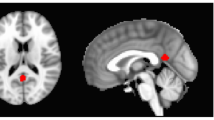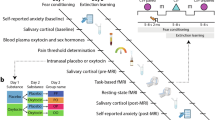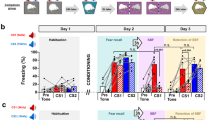Abstract
In human evolution, social group living and Pavlovian fear conditioning have evolved as adaptive mechanisms promoting survival and reproductive success. The evolutionarily conserved hypothalamic peptide oxytocin is a key modulator of human sociality, but its effects on fear conditioning are still elusive. In the present randomized controlled study involving 97 healthy male subjects, we therefore employed functional magnetic resonance imaging and simultaneous skin conductance response (SCR) measures to characterize the modulatory influence of intranasal oxytocin (24 IU) on Pavlovian fear conditioning. We found that the peptide strengthened conditioning on both the behavioral and neural levels. Specifically, subjects exhibited faster task-related responses and enhanced SCRs to fear-associated stimuli in the late phase of conditioning, which was paralleled by heightened activity in cingulate cortex subregions in the absence of changes in amygdala function. This speaks against amygdalocentric views of oxytocin having pure anxiolytic-like effects. Instead, it suggests that the peptide enables extremely rapid and flexible adaptation to fear signals in social contexts, which may confer clear evolutionary advantages but could also elevate vulnerability for the pathological sequelae of interpersonal trauma.
Similar content being viewed by others
Log in or create a free account to read this content
Gain free access to this article, as well as selected content from this journal and more on nature.com
or
References
Becker B, Androsch L, Jahn RT, Alich T, Striepens N, Markett S et al (2013). Inferior frontal gyrus preserves working memory and emotional learning under conditions of impaired noradrenergic signaling. Front Behav Neurosci 7: 197.
Boccia M, Petrusz P, Suzuki K, Marson L, Pedersen C (2013). Immunohistochemical localization of oxytocin receptors in human brain. Neuroscience 253: 155–164.
Bremner JD, Vermetten E, Schmahl C, Vaccarino V, Vythilingam M, Afzal N et al (2005). Positron emission tomographic imaging of neural correlates of a fear acquisition and extinction paradigm in women with childhood sexual-abuse-related post-traumatic stress disorder. Psychol Med 35: 791–806.
Brett M, Anton J-L, Valabregue R, Poline J-B (2002). Region of interest analysis using the MarsBar toolbox for SPM 99. Neuroimage 16: S497.
Büchel C, Morris J, Dolan RJ, Friston KJ (1998). Brain systems mediating aversive conditioning: an event-related fMRI study. Neuron 20: 947–957.
Cantor C (2009). Post-traumatic stress disorder: evolutionary perspectives. Aust N Z J Psychiatry 43: 1038–1048.
Critchley HD, Mathias CJ, Dolan RJ (2002). Fear conditioning in humans: the influence of awareness and autonomic arousal on functional neuroanatomy. Neuron 33: 653–663.
De Dreu CK, Greer LL, Handgraaf MJ, Shalvi S, Van Kleef GA, Baas M et al (2010). The neuropeptide oxytocin regulates parochial altruism in intergroup conflict among humans. Science 328: 1408–1411.
Domes G, Heinrichs M, Gläscher J, Büchel C, Braus DF, Herpertz SC (2007). Oxytocin attenuates amygdala responses to emotional faces regardless of valence. Biol Psychiatry 62: 1187–1190.
Drevets WC, Savitz J, Trimble M (2008). The subgenual anterior cingulate cortex in mood disorders. CNS Spectr 13: 663–681.
Dunbar RI, Shultz S (2007). Evolution in the social brain. Science 317: 1344–1347.
Eckstein M, Becker B, Scheele D, Scholz C, Preckel K, Schlaepfer TE et al (2014b). Oxytocin facilitates the extinction of conditioned fear in humans. Biol Psychiatry 78: 194–202.
Eckstein M, Hurlemann R (2013). Oxytocin—evidence for a therapeutic potential of the social neuromodulator. Der Nervenarzt 84: 1321–1328.
Eckstein M, Scheele D, Weber K, Stoffel‐Wagner B, Maier W, Hurlemann R (2014a). Oxytocin facilitates the sensation of social stress. Hum Brain Mapp 35: 4741–4750.
Eskandarian S, Vafaei AA, Vaezi GH, Taherian F, Kashefi A, Rashidy-Pour A (2013). Effects of systemic administration of oxytocin on contextual fear extinction in a rat model of post-traumatic stress disorder. Basic Clin Neurosci 4: 315–322.
Gaebler M, Daniels JK, Lamke J-P, Fydrich T, Walter H (2014). Behavioural and neural correlates of self-focused emotion regulation in social anxiety disorder. J Psychiatry Neurosci 39: 249–258.
Gorka SM, Fitzgerald DA, Labuschagne I, Hosanagar A, Wood AG, Nathan PJ et al (2015). Oxytocin modulation of amygdala functional connectivity to fearful faces in generalized social anxiety disorder. Neuropsychopharmacology 40: 278–286.
Guastella AJ, Hickie IB, McGuinness MM, Otis M, Woods EA, Disinger HM et al (2013). Recommendations for the standardisation of oxytocin nasal administration and guidelines for its reporting in human research. Psychoneuroendocrinology 38: 612–625.
Hamner MB, Lorberbaum JP, George MS (1999). Potential role of the anterior cingulate cortex in PTSD: review and hypothesis. Depress Anxiety 1–14.
Hariri AR, Mattay VS, Tessitore A, Fera F, Weinberger DR (2003). Neocortical modulation of the amygdala response to fearful stimuli. Biol Psychiatry 53: 494–501.
Heeren A, Mogoase C, McNally RJ, Schmitz A, Philippot P (2015). Does attention bias modification improve attentional control? A double-blind randomized experiment with individuals with social anxiety disorder. J Anxiety Disord 29: 35–42.
Herry C, Johansen JP (2014). Encoding of fear learning and memory in distributed neuronal circuits. Nat Neurosci 17: 1644–1654.
Hurlemann R, Patin A, Onur OA, Cohen MX, Baumgartner T, Metzler S et al (2010). Oxytocin enhances amygdala-dependent, socially reinforced learning and emotional empathy in humans. J Neurosci 30: 4999–5007.
Hurlemann R, Rehme AK, Diessel M, Kukolja J, Maier W, Walter H et al (2008). Segregating intra-amygdalar responses to dynamic facial emotion with cytoarchitectonic maximum probability maps. J Neurosci 172: 13–20.
Hurlemann R, Scheele D (2015). Dissecting the role of oxytocin in the formation and loss of social relationships. Biol Psychiatry. doi: 10.1016/j.biopsych.2015.05.013.
Kessler RC, Sonnega A, Bromet E, Hughes M, Nelson CB (1995). Posttraumatic stress disorder in the National Comorbidity Survey. Arch Gen Psychiatry 52: 1048–1060.
Knobloch HS, Charlet A, Hoffmann LC, Eliava M, Khrulev S, Cetin AH et al (2012). Evoked axonal oxytocin release in the central amygdala attenuates fear response. Neuron 73: 553–566.
Kosfeld M, Heinrichs M, Zak PJ, Fischbacher U, Fehr E (2005). Oxytocin increases trust in humans. Nature 435: 673–676.
LaBar KS, Gatenby JC, Gore JC, LeDoux JE, Phelp EA (1998). Human amygdala activation during conditioned fear acquisition and extinction: a mixed-trial fMRI study. Neuron 20: 937–945.
Labuschagne I, Phan KL, Wood A, Angstadt M, Chua P, Heinrichs M et al (2010). Oxytocin attenuates amygdala reactivity to fear in generalized social anxiety disorder. Neuropsychopharmacology 35: 2403–2413.
Lischke A, Gamer M, Berger C, Grossmann A, Hauenstein K, Heinrichs M et al (2012). Oxytocin increases amygdala reactivity to threatening scenes in females. Psychoneuroendocrinology 37: 1431–1438.
Lissek S, Levenson J, Biggs AL, Johnson LL, Ameli R, Pine DS et al (2008). Elevated fear conditioning to socially relevant unconditioned stimuli in social anxiety disorder. Am J Psychiatry 165: 124–132.
Lissek S, van Meurs B (2014). Learning models of PTSD: Theoretical accounts and psychobiological evidence. Int J Psychophysiology. doi: 10.1016/j.ijpsycho.2014.11.006.
Milad MR, Quirk GJ, Pitman RK, Orr SP, Fischl B, Rauch SL (2007). A role for the human dorsal anterior cingulate cortex in fear expression. Biol Psychiatry 62: 1191–1194.
Öhman A, Mineka S (2001). Fears, phobias, and preparedness: toward an evolved module of fear and fear learning. Psychol Rev 108: 483–522.
Olff M, Koch SB, Nawijn L, Frijling JL, Van Zuiden M, Veltman DJ (2014). Social support, oxytocin and PTSD. Eur J Psychotraumatol 5: 26513.
Preckel K, Scheele D, Kendrick KM, Maier W, Hurlemann R (2014). Oxytocin facilitates social approach behavior in women. Front Behav Neurosci 8: 191.
Rash JA, Aguirre-Camacho A, Campbell TS (2014). Oxytocin and pain: a systematic review and synthesis of findings. Clin J Pain 30: 453–462.
Rauch SL, Shin LM, Phelps EA (2006). Neurocircuitry models of posttraumatic stress disorder and extinction: human neuroimaging research—past, present, and future. Biol Psychiatry 60: 376–382.
Rilling JK, Young LJ (2014). The biology of mammalian parenting and its effect on offspring social development. Science 345: 771–776.
Scheele D, Kendrick KM, Khouri C, Kretzer E, Schläpfer TE, Stoffel-Wagner B et al (2014a). An oxytocin-induced facilitation of neural and emotional responses to social touch correlates inversely with autism traits. Neuropsychopharmacology 39: 2078–2085.
Scheele D, Striepens N, Güntürkün O, Deutschländer S, Maier W, Kendrick KM et al (2012). Oxytocin modulates social distance between males and females. J Neurosci 32: 16074–16079.
Scheele D, Striepens N, Kendrick KM, Schwering C, Noelle J, Wille A et al (2014b). Opposing effects of oxytocin on moral judgment in males and females. Hum Brain Mapp 35: 6067–6076.
Scheele D, Wille A, Kendrick KM, Stoffel-Wagner B, Becker B, Güntürkün O et al (2013). Oxytocin enhances brain reward system responses in men viewing the face of their female partner. Proc Natl Acad Sci USA 110: 20308–20313.
Sehlmeyer C, Schöning S, Zwitserlood P, Pfleiderer B, Kircher T, Arolt V et al (2009). Human fear conditioning and extinction in neuroimaging: a systematic review. PLoS One 4: e5865.
Shackman AJ, Salomons TV, Slagter HA, Fox AS, Winter JJ, Davidson RJ (2011). The integration of negative affect, pain and cognitive control in the cingulate cortex. Nat Rev Neurosci 12: 154–167.
Shahrestani S, Kemp AH, Guastella AJ (2013). The impact of a single administration of intranasal oxytocin on the recognition of basic emotions in humans: a meta-analysis. Neuropsychopharmacology 38: 1929–1936.
Sheehan D, Lecrubier Y, Sheehan KH, Janavs J, Weiller E, Keskiner A et al (1997). The validity of the Mini International Neuropsychiatric Interview (MINI) according to the SCID-P and its reliability. Eur Psychiatry 12: 232–241.
Shin LM, Wright CI, Cannistraro PA, Wedig MM, McMullin K, Martis B et al (2005). A functional magnetic resonance imaging study of amygdala and medial prefrontal cortex responses to overtly presented fearful faces in posttraumatic stress disorder. Arch Gen Psychiatry 62: 273–281.
Striepens N, Scheele D, Kendrick KM, Becker B, Schäfer L, Schwalba K et al (2012). Oxytocin facilitates protective responses to aversive social stimuli in males. Proc Natl Acad Sci USA 109: 18144–18149.
Taylor SE, Saphire-Bernstein S, Seeman TE (2010). Are plasma oxytocin in women and plasma vasopressin in men biomarkers of distressed pair-bond relationsship? Psychol Sci 21: 3–7.
Vogt BA (2005). Pain and emotion interactions in subregions of the cingulate gyrus. Nat Rev Neurosci 6: 533–544.
Zoicas I, Slattery DA, Neumann ID (2014). Brain oxytocin in social fear conditioning and its extinction: involvement of the lateral septum. Neuropsychopharmacology 39: 3027–3035.
Acknowledgements
We thank Claudia Scholz for her help with data collection and Paul Jung for providing technical support.
Author contributions
ME, DS, and RH designed the experiments; ME, AW, and KP conducted the experiments; ME, DS, BB, AW, and RH analyzed the data; and all the authors wrote the paper.
Author information
Authors and Affiliations
Corresponding author
Additional information
Supplementary Information accompanies the paper on the Neuropsychopharmacology website
Supplementary information
PowerPoint slides
Rights and permissions
About this article
Cite this article
Eckstein, M., Scheele, D., Patin, A. et al. Oxytocin Facilitates Pavlovian Fear Learning in Males. Neuropsychopharmacol 41, 932–939 (2016). https://doi.org/10.1038/npp.2015.245
Received:
Revised:
Accepted:
Published:
Issue date:
DOI: https://doi.org/10.1038/npp.2015.245
This article is cited by
-
Effects of exogenous oxytocin and estradiol on resting-state functional connectivity in women and men
Scientific Reports (2023)
-
Sniffing oxytocin: Nose to brain or nose to blood?
Molecular Psychiatry (2023)
-
Placebo and nocebo effects: from observation to harnessing and clinical application
Translational Psychiatry (2022)
-
Oxytocin-based therapies for treatment of Prader-Willi and Schaaf-Yang syndromes: evidence, disappointments, and future research strategies
Translational Psychiatry (2022)
-
Intranasal oxytocin administration impacts the acquisition and consolidation of trauma-associated memories: a double-blind randomized placebo-controlled experimental study in healthy women
Neuropsychopharmacology (2022)



